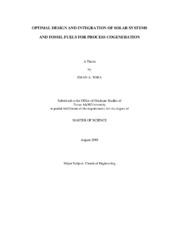| dc.description.abstract | Because of the fluctuations in incident solar power, outlet power also changes over
time (e.g., on an hourly basis or seasonally). If there is a need for a stable power outlet,
there are options towards a steady state output of the system. This work is aimed at the
development of systematic design procedures for two solar-based power generation
strategies.
The first is integration of fossil-fuel with the solar system to provide a compensation
effect (power backup to supplement the power main source from solar energy).
The second is the use of thermal energy storage (TES) systems to save solar energy
in a thermal form and use it when solar input decreases. A common TES configuration is
the two-tank system which allows the use of the collector heat transfer fluid (HTF) as a
storing medium. For the two tanks, one tank has the hot medium (e.g., a molten salt) and
the second has the cold storage media.
Specifically, the following design challenges are addressed:
1. What is the optimal mix of energy forms to be supplied to the process? 2. What are the optimal scenario and integration mode to deliver the selected energy
forms? How should they be integrated among themselves and with the process?
3. What is the optimal design of the energy systems?
4. What is the optimal dynamic strategy for operating the various energy systems?
5. What is the feasibility of using thermal energy storage to this optimum fossil fuel
system?
The developed procedure includes gathering and generation of relevant solar and
climatic data, modeling of the various components of the solar, fossil, and power
generation systems, and optimization of several aspects of the hybrid system. A case
study is solved to demonstrate the effectiveness and applicability of the devised
procedure. | en |


